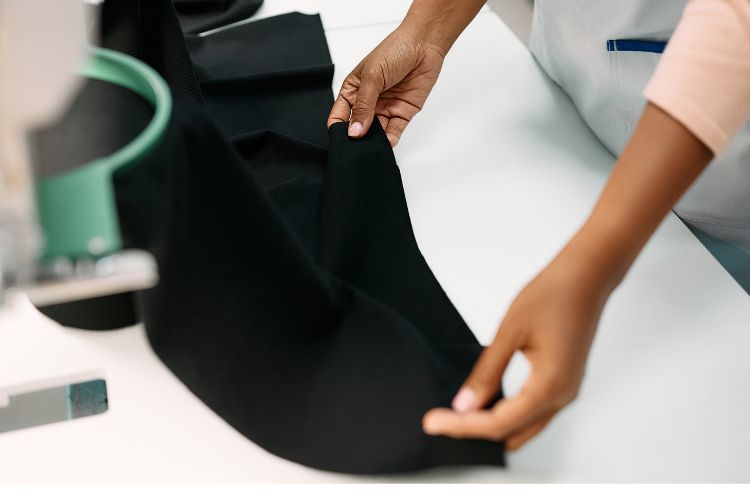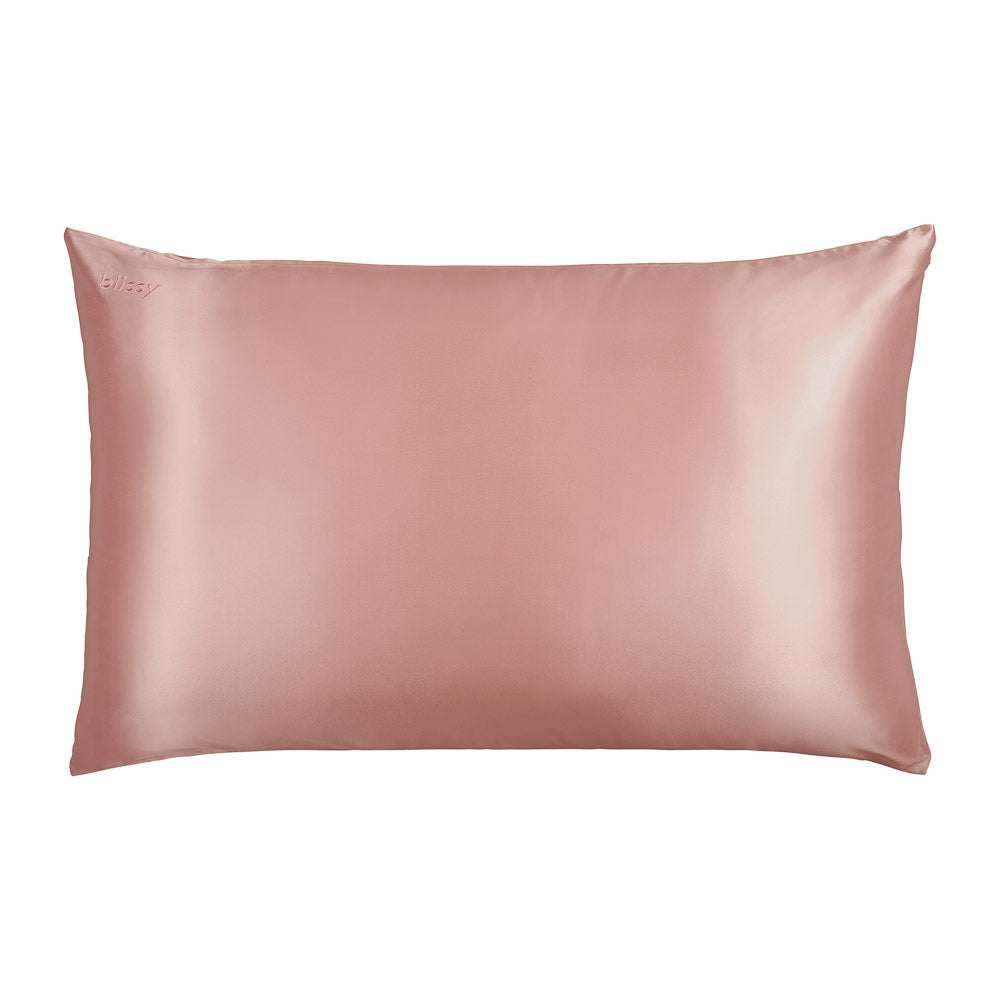Key Takeaways:
-
Satin, usually synthetic, may carry toxins from production.
-
Common harmful chemicals include formaldehyde, azo dyes, and heavy metals.
-
Look for OEKO-TEX or choose natural materials for safety.
-
Silk pillowcases are hypoallergenic, breathable, and toxin-free.
Satin is often praised for its shiny surface and silky feel, but what it’s actually made of may surprise you. Unlike natural fibers such as pure silk, most satin on the market is woven from synthetic materials like polyester or nylon. That means the fabric can carry dyes, finishes, and other harmful toxins from its highly artificial production process, which gives it its smooth feel.
This raises concerns for people with sensitive skin, as satin can cause irritation, snag hair, and lacks the protective qualities of a silk pillowcase, which is naturally hypoallergenic and better for long-term well being.
Before assuming satin is the same as silk—or a safe substitute—it’s important to understand what satin really is, how it’s made, and why it’s not comparable to natural fibres like silk.
What Is Satin Made Of?
Quick answer ✨
Most satin sold today is woven from synthetic fibers like polyester or nylon, while only ‘silk satin’ is made with natural silk.
Usually, polyester, rayon, or nylon fibers are used to weave the threads into a "satin weave." The result is a seemingly luxurious shiny fabric, though satin does not have the same benefits as silk, since it's created with synthetic materials with harmful additives.

There are several kinds of satin and satin weaves including:
- Antique satin
- Surf satin weaves
- Slipper satin
- Double-faced satin weaves
- Polyester satin
Satin is often marketed for benefits like durability, wrinkle resistance, and elegant drape. In reality, most satin is made to be affordable, using synthetic fibers that only mimic luxury while lacking the safety and quality of natural materials.
So, while you might think that silk and satin are comparable, the truth is that they're nothing alike.
Satin vs Silk: Synthetic Weave vs Natural Silk

Satin is not a fiber like silk or cotton—it’s a type of fabric weave, and unless labeled ‘silk satin,’ it almost always means synthetic fabric such as polyester.
Satin is known for its glossy surface and silky feel, achieved through a specific type of weave called a satin weave, where warp yarns float over weft yarns. This technique creates a fabric that shines on one side while remaining matte on the reverse, making it popular for satin pillowcases, evening wear, and fashion accessories.
Unlike silk, which is natural, satin is often made from synthetic fibers like polyester, making it durable and wrinkle-resistant, yet not quite matching silk's natural elegance or purity. Satin offers a luxurious look without the silk price tag, serving as a versatile fabric choice in both wardrobe and home decor.
However, while satin pillowcase companies claim that satin fabric offers the same benefits as pure silk, this is simply not true.
Satin’s Chemical Makeup: Hidden Toxins and Harmful Chemicals
Most satin is made from synthetic fibers that can contain dyes, finishes, and other harmful chemicals, raising concerns about hidden toxins and allergic reactions. While its glossy look and soft texture make satin popular for pillowcases and fashion accessories, the way it’s produced can still expose you to potentially harmful substances.
Chemicals like formaldehyde, prevalent in satin weaves, pose risks to skin and overall health. Additionally, Azo dyes, used in many variations of satin fabric, have been linked to skin irritation and cancer.
Recognizing the potential dangers within satin fabrics empowers individuals to prioritize safer alternatives, such as natural materials like cotton or silk. By opting for OEKO-TEX certified products or those made with organic materials, consumers can enjoy the luxurious feel of satin without compromising their well-being.
Making informed decisions about bedding and clothing purchases ensures not only comfort but also peace of mind, knowing that you're resting on fabrics free from harmful chemicals.
What Chemicals Are in Satin Fabric?

To achieve its silky texture, satin fabric is treated with finishes and dyes that can leave behind harmful chemicals. Some of the most concerning chemicals found in satin include:
-
Formaldehyde
-
Azo dyes (some which are associated with cancer)
-
Heavy metals like cadmium or mercury
-
Organotin compounds
-
Chlorobenzenes
Sometimes, the function of the chemicals makes them necessary. For example, satin evening gowns, bridal wear, and evening bags might be made with flame retardants to prevent accidents near candles. Unfortunately, flame retardants may bioaccumulate. They build up in the body. Over time, they can cause problems ranging from infertility to cancer.
Other chemicals used in the creation of satin material can lead to dermatitis and allergies. For instance, AZO dyes, which are used to color textiles into vivid colors, can come off and come into contact with the skin. In a worst-case scenario, those AZO dyes could break down into aromatic amines and cause cancer.
Chemicals like chlorobenzene are troublesome, too. Why? They can accumulate in your body. They have the potential to irritate or affect the thyroid, nervous system, and liver. In some places, like in the European Union, their use is restricted.
What Can I Do To Avoid Satin Toxins?

To avoid the harmful toxins and various chemicals sometimes found in satin, look for OEKO-TEX certified products or switch to natural fibers like silk, which is naturally hypoallergenic and supports overall well-being.
One of the best things to do is to seek products with a third-party certification. The OEKO-TEX Standard 100 certification on bed linens gives you peace of mind that your products are free from harmful chemicals.
You may also want to switch to choosing natural materials. The most common natural fabric options in the United States include cotton, silk, leather, and wool. Silk, in particular has naturally hypoallergenic properties and provides numerous benefits for hair and skin.
Always read the information provided about the material. Use that information to determine if dangerous dyes or treatments were used on the products. If so, opt for a different brand or product that has received safety certifications.
At Blissy, we suggest switching to silk instead of satin. Silk is a healthier alternative to satin and has many health benefits.
Silk is:
- Hypoallergenic
- Breathable
- Anti-aging
- Anti-bacterial
- Bug resistant
- Non-irritating
- Beneficial for skin & hair
Silk vs Satin Pillowcase: Why Mulberry Silk Is a Healthier Alternative
When comparing a silk vs satin pillowcase, silk—especially 100% mulberry silk—is the healthier alternative because it’s free of harmful chemicals and made from natural fibres.

Silk is a durable, natural fiber and a renewable resource with a glossy surface. Rich in natural amino acids, silk pillowcases feel far more luxurious and are free of the hazardous toxins often found in manmade fabrics.
When you choose materials like 100% mulberry silk, you’re investing in quality, safety, and long-term care for your hair and skin.
While silk often has to be hand-washed, Blissy pillow covers are machine-washable. Just check out our care instructions.
Blissy uses 100% natural mulberry silk in all our products. Their products also have OEKO-TEX certification, because they are safe, eco-friendly, and non-toxic.
Blissy silk is nothing like the synthetic satin you've experienced in the past. It doesn't contain the harmful chemicals you could find in satin and sateen materials, so you can rest easy knowing you're not harming your body.
























































